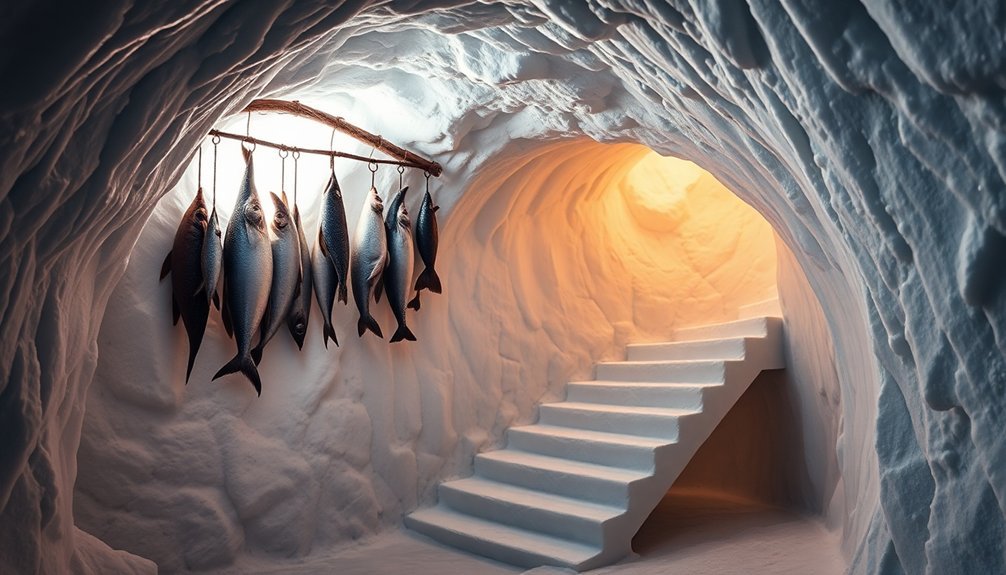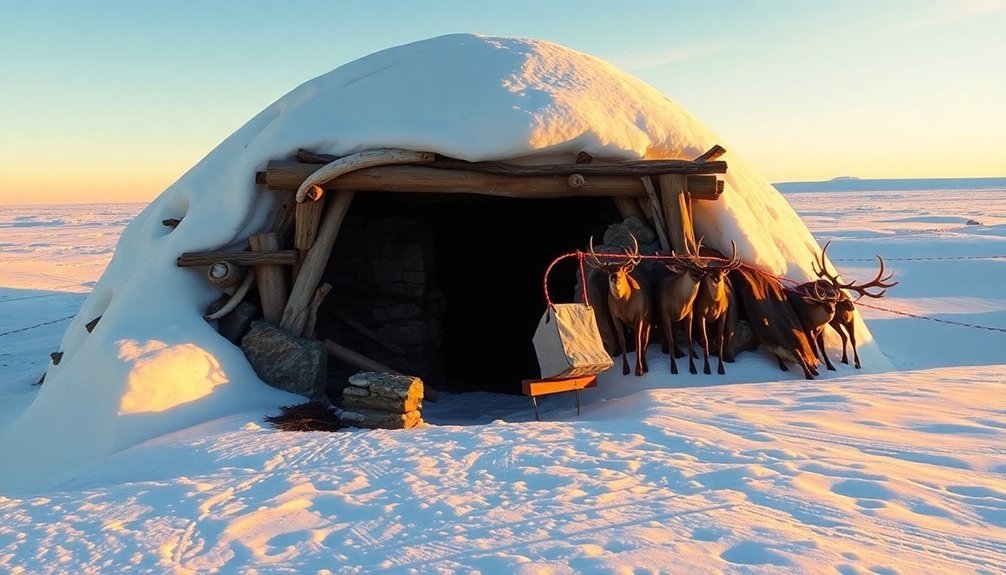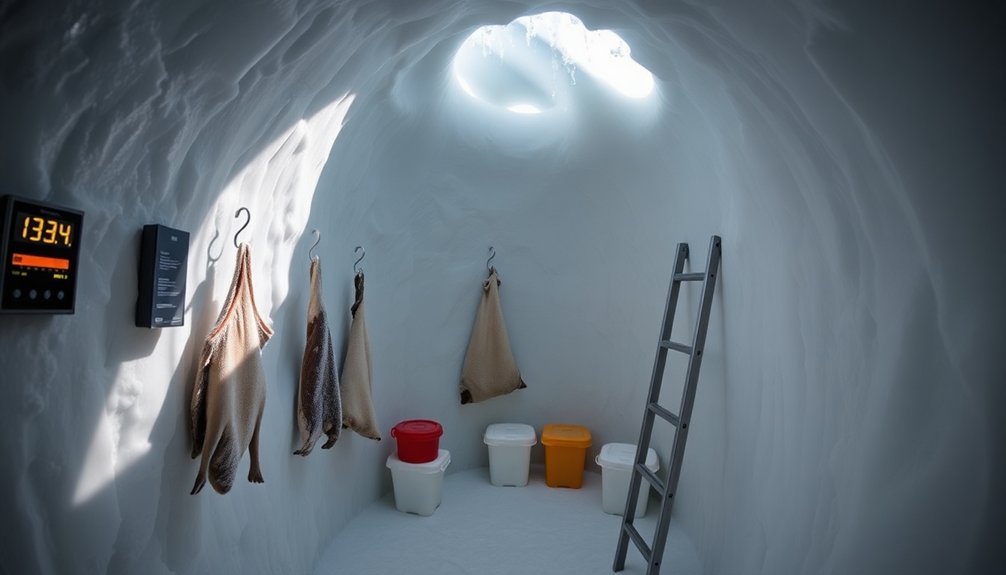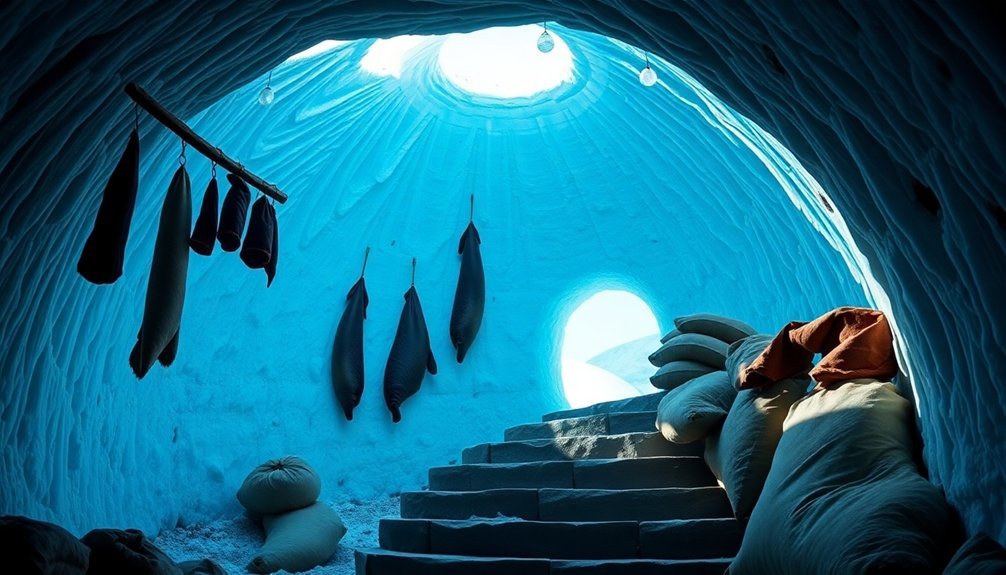Indigenous ice houses showcase remarkable Arctic engineering that you'll find fascinating. These structures combine traditional knowledge with smart design features like double-layered walls and strategic northern placement to maintain cold temperatures year-round. You'll discover how these cellars preserve traditional foods through natural cooling methods, often surpassing modern alternatives in nutritional value and cultural significance. While climate change now threatens these time-tested storage systems, communities are adapting by integrating modern innovations like thermosyphons with ancestral techniques. As Arctic temperatures rise, understanding these sustainable preservation methods becomes increasingly essential to food security and cultural heritage.
Ancient Arctic Engineering Marvel

Throughout the harsh Arctic environment, indigenous peoples developed remarkable engineering solutions for survival, with the igloo standing as their crowning achievement.
When you examine an igloo's construction, you'll find it's an architectural marvel that follows precise mathematical principles, particularly in its catenary arch design that efficiently distributes weight from top to bottom. Burial in snow and ice was a traditional method of food preservation in these regions.
You'll notice that each snow block must be placed with extraordinary precision, touching the row below only at its corners to maintain structural integrity. The igloo's stability depends on a specific height-to-diameter ratio of 3:10, meaning a 6-foot-tall structure requires a 10-foot-wide base.
What makes this engineering even more impressive is how the blocks work together to create a line of compressive force, channeling the weight through each block down to the foundation.
The success of an igloo relies heavily on the builder's ability to select the right snow quality.
When properly constructed, these structures demonstrate indigenous peoples' deep understanding of engineering principles, creating shelters that could withstand extreme Arctic conditions while providing essential food storage capabilities in a region where preservation was vital for survival.
Climate Threats to Cultural Heritage
In the face of rapid climate change, Arctic Indigenous communities are witnessing unprecedented threats to their cultural heritage. Coastal erosion and thawing permafrost are destroying critical heritage sites like Nuvugaq, while previously preserved artifacts are now rotting after centuries of frozen preservation.
You'll find that these changes aren't just affecting physical structures – they're erasing irreplaceable cultural knowledge. Arctic temperatures are rising twice as fast as the global average.
When you look at traditional hunting and fishing practices, you'll see how climate disruption is severely impacting Indigenous livelihoods. The changing sea ice patterns are making trail systems dangerous, while shifts in wildlife behavior are forcing communities to abandon time-honored hunting grounds.
You're witnessing a dramatic transformation as killer whales expand their territory and traditionally harvested species become scarcer.
The threat extends to historical buildings and monuments, which weren't built to withstand today's warming climate. You'll notice increasing damage from geohazards like landslides and rockfalls, while coastal erosion continues to compromise cultural sites.
As communities shift from traditional foods to store-bought alternatives, they're not just losing nutrition – they're losing essential connections to their ancestral practices and knowledge systems.
Building the Traditional Storage System

Traditional ice house construction begins with three critical steps: selecting an ideal site, preparing the foundation, and establishing proper drainage. You'll want to choose northern slopes or gullies where natural cold conditions prevail, especially in permafrost areas where you'll only need to dig a few feet down. Families who invest in proper ice house construction often find it to be a cheap luxury that pays for itself through food preservation savings.
| Component | Construction Method |
|---|---|
| Walls | Double-layered stone/brick with sawdust filling |
| Roof | High-pitched design with ventilation gaps |
| Floor | Reinforced wooden boards with drainage system |
| Insulation | Sawdust, hay, or rock wool between partitions |
Once you've established your foundation, you'll need to build strong walls using double partitions filled with non-conducting materials. Your roof should have a considerable pitch to allow warm air to escape, while the doors must be positioned to minimize heat entry. You'll want to incorporate proper ventilation through lattice windows or convection systems.
For the storage area, you'll need to create layers using sawdust or wood shavings between ice blocks. Install a reliable drainage system to prevent water accumulation, and use traditional materials like birch or larch bark to maintain cleanliness and prevent odors.
Community Food Security Solutions
While ice house construction provides the foundation for food storage, preserving food security within indigenous communities demands a combination of time-tested methods and cultural knowledge.
You'll find traditional preservation techniques like drying, smoking, and fermentation remain essential for extending food shelf life while maintaining cultural identity. These methods don't just preserve food – they're crucial links to ancestral wisdom passed down through generations.
You're facing unprecedented challenges as climate change disrupts traditional hunting patterns and alters sea ice conditions. It's now taking longer and costing more to harvest traditional foods, with more than one-third of Nunavut households struggling to access safe, healthy food.
However, you can't overlook the superior nutritional value of traditional foods compared to store-bought alternatives. When you consume wild-caught caribou or arctic char, you're getting more nutrients while protecting yourself from diet-related health issues.
To strengthen food security, you'll need to combine traditional preservation methods with community-based initiatives.
These solutions aren't just about preventing hunger – they're about preserving cultural practices, supporting ecological knowledge, and maintaining community health in a rapidly changing Arctic environment.
Modern Adaptations of Ice Cellars

Today's Arctic communities are adapting their ancestral ice cellars with innovative technologies to combat permafrost thaw. You'll find thermosyphons leading this adaptation, as they're proving to be effective, low-cost solutions for maintaining freezing temperatures in these traditional storage spaces. These devices work by transferring heat from the surrounding permafrost to the surface, keeping the cellars frozen year-round.
You can see this technology's success in Kaktovik, where the community launched a groundbreaking project in 2013. They've built a modern ice cellar that combines traditional designs with off-grid refrigeration systems similar to those used in Alaska's North Slope oil fields. Temperature sensors confirm it's working as planned, and there are now efforts to expand this approach to other locations.
If you're maintaining an ice cellar, you'll need to monitor humidity and temperature regularly. The Iñupiat Community of the Arctic Slope is actively working to preserve these essential structures by installing thermosyphons and reinforcing existing cellars.
They're developing these solutions in consultation with local communities to guarantee both food security and cultural preservation remain intact.
Frequently Asked Questions
How Long Can Whale Meat Remain Safely Preserved in a Traditional Ice Cellar?
You'll find that whale meat can stay preserved for up to a year in a properly functioning ice cellar, but today's warming temperatures mean you'll need to monitor conditions closely to guarantee safe storage.
What Specific Maintenance Tasks Are Required to Keep Ice Cellars Operational Year-Round?
You'll need to clear snow, remove debris, check structural integrity, monitor temperature/humidity levels, guarantee proper ventilation, clean annually before harvest, and inspect for permafrost thawing to keep ice cellars working throughout the year.
Can Modern Communities Establish New Ice Cellars in Previously Unused Locations?
You can establish new ice cellars in suitable locations by selecting north-facing slopes, ensuring proper drainage, installing adequate insulation, and following traditional design principles while incorporating modern materials and cooling technologies when needed.
How Do Different Arctic Communities Share Knowledge About Ice Cellar Construction?
You'll find Arctic communities share ice cellar knowledge through elder teachings, collaborative workshops, partnership programs with scientists, and cross-cultural gatherings where traditional construction techniques and maintenance practices are actively exchanged between communities.
What Alternative Foods Do Communities Rely on When Ice Cellars Become Unusable?
When ice cellars fail, you'll find communities relying on dried fish, smoked meats, fermented foods, and store-bought items. They'll also increase their use of modern freezers and share preserved foods between households.
In Summary
You've seen how ice cellars represent more than just food storage – they're a demonstration of indigenous ingenuity that's served Arctic communities for generations. While climate change threatens these traditional systems, you're witnessing communities adapt and combine ancient knowledge with modern technology. As you look to the future, it's clear these ice houses remain essential to both cultural preservation and food security in the changing Arctic.





Leave a Reply